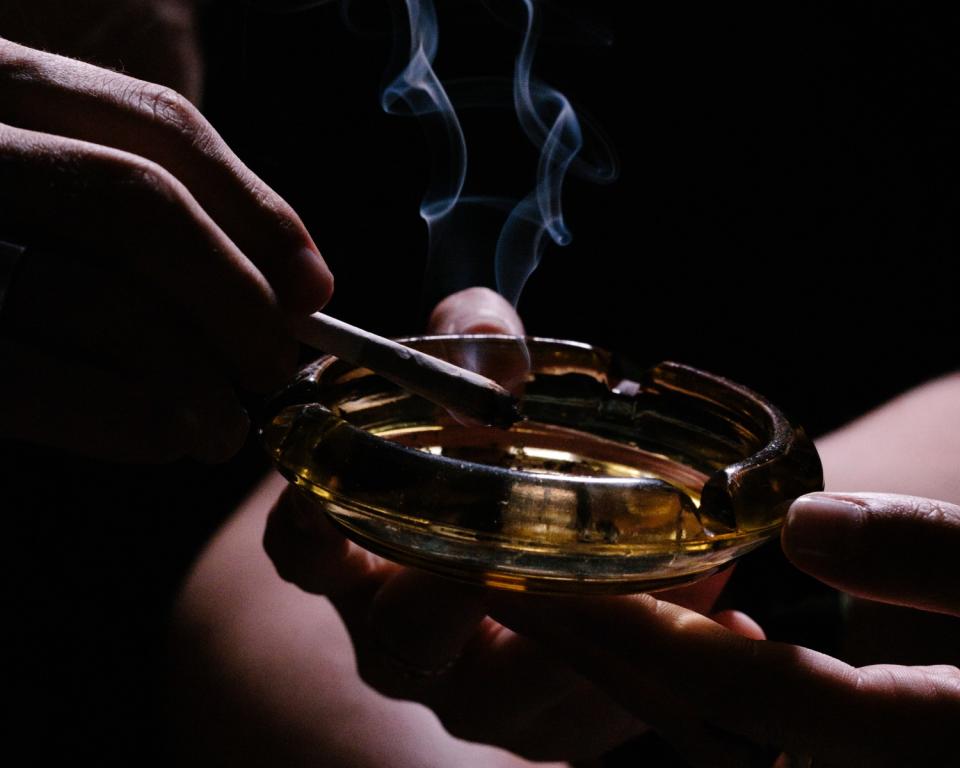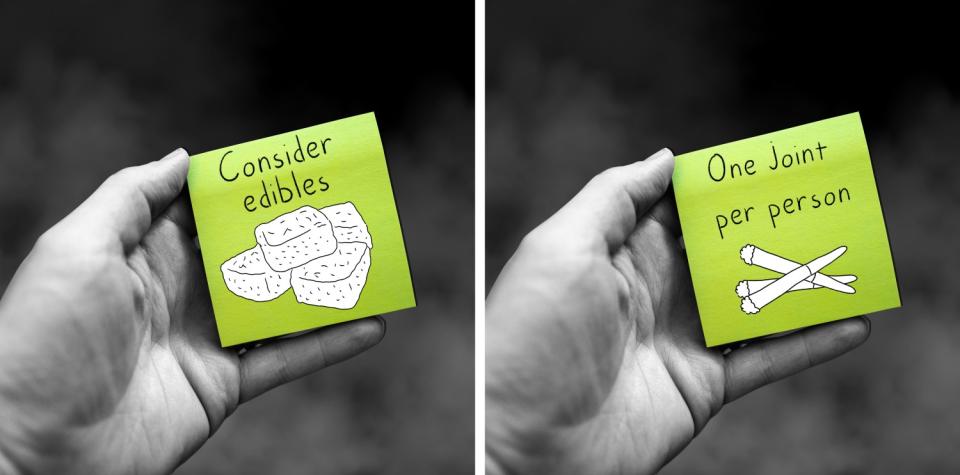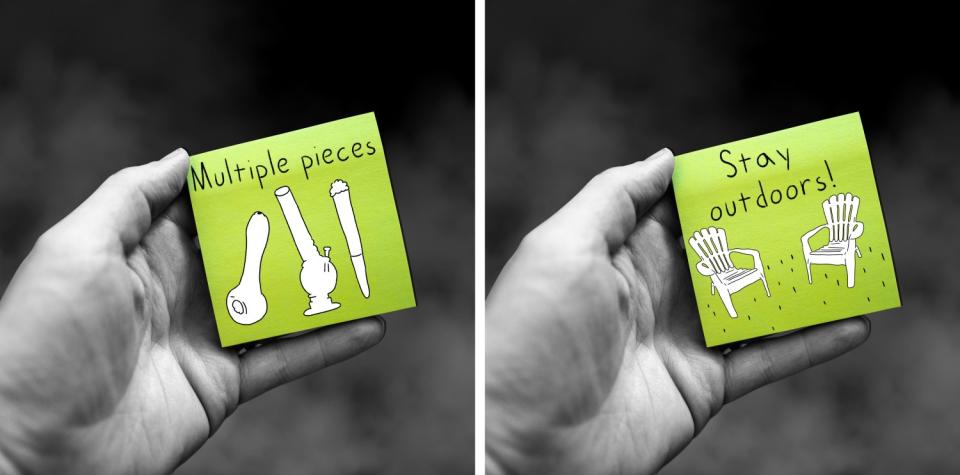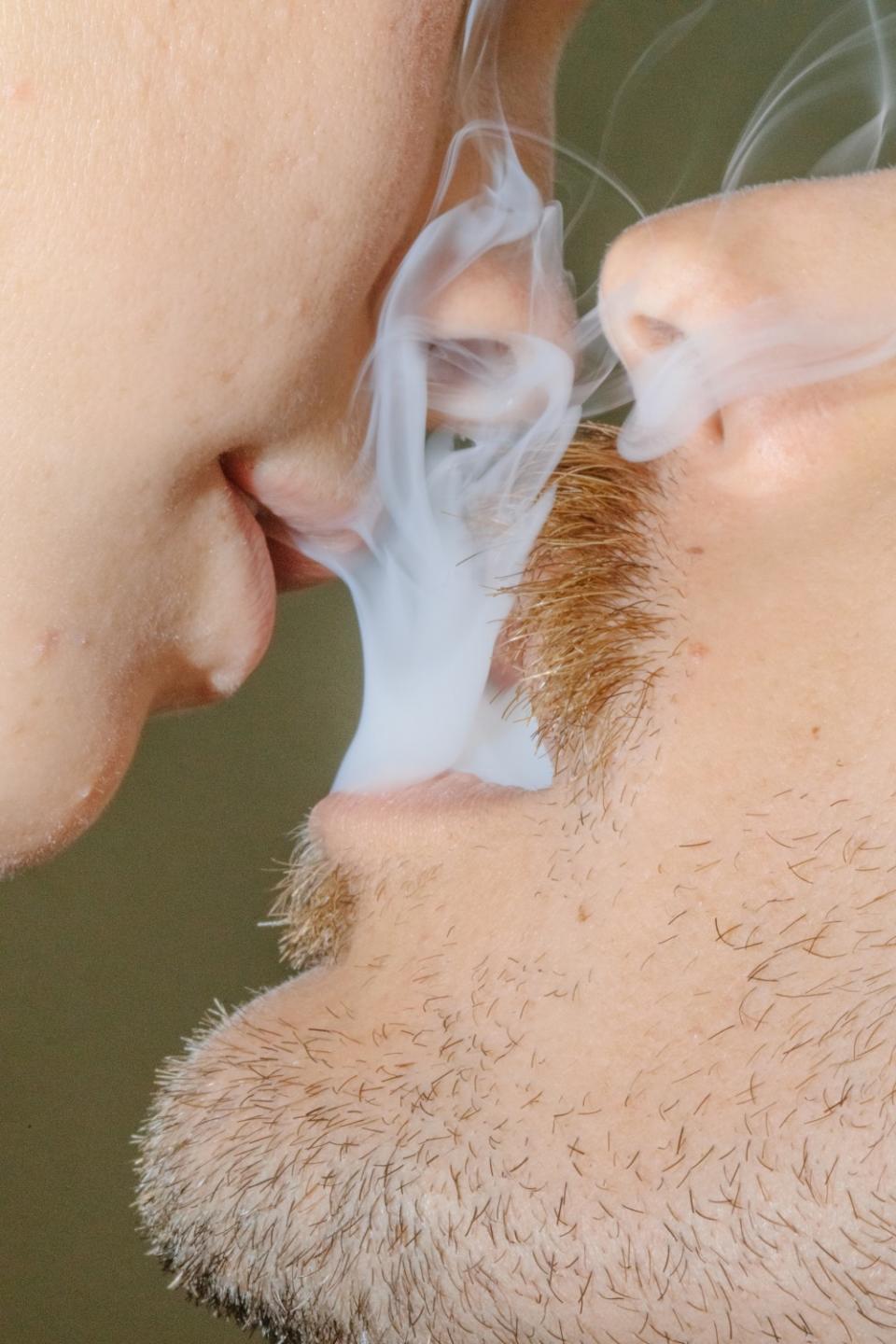COVID-19 took the joy out of social pot-smoking. Then I found a way to bring it back

Sitting by the pool at a boutique hotel in Palm Springs on a one-night, mid-August getaway, I struck up a conversation with a guy named Gary. I didn't know anything about my fellow sun-worshipper except where he was from (Huntington Beach), that he'd grown up in the 1970s (he had seen Jimi Hendrix and the Doors perform live) and that he was down to chat about cannabis. I, just a few days out from touring cannabis label Ball Family Farms' L.A. grow (for a profile of its founder and Chief Executive Chris Ball), was more than willing to oblige.
Gary and I talked growing laws (in California you can grow up to six mature plants). We talked about how THC-infused edibles are metabolized differently, and I told him about my recent adventures in pot-plant parenthood (and how reluctant I was when it came to actually smoking my baby). He told me about his neighbor's towering plants that leaned like light-seeking sunflowers over their shared fence.
After chatting for several hours over the course of two sun-drenched days, I felt as if Gary and I were part of the same community of cannabis enthusiasts. (Let's call us "cannathusiasts," shall we?) Even though I wasn't 100% sure Gary actually smoked weed (or ever had) I felt, I had found a kindred spirit because we had bonded over all things bud.
In the before times, I would have responded to this almost magnetic tug in my chest by brandishing some pot — either a pre-rolled joint or an already packed pipe — and offering to get us both high. However, I was worried about catching COVID-19, not about getting caught. (I’d be smart enough to furtively fire up off property; this wasn’t my first rodeo.) After all, just last year the world was wondering whether we'd ever feel the magic of a first kiss again and there were reports that the friendly handshake was going the way of the dodo.
I'd only gotten baked outside my bubble two or maybe three times since the early days of the pandemic but I always had the foresight to make sure everyone had a designated piece of paraphernalia. One (pre-vaccine) time, though, I unexpectedly shared a few puffs of a joint with a famous rock star. For two weeks, I was horrified I'd end up becoming infamous for accidentally killing a music icon with COVID-19. That tickling terror of transmission hung over me like a cloud for a long time, and it's exactly the kind of buzzkill that takes all the fun out of a spontaneous opportunity to expand one's smoking circle. It left me equal parts angry, frustrated and socially isolated.
I'm not alone. For many members of the toking tribe, discovering another like-minded soul out in the wild, the first impulse is to share. Passing a lighted joint to another human being — whether puffing poolside in Palm Springs or blazing in your own backyard with a new neighbor — is the kind of secret handshake that makes two strangers fast friends and even the most mundane moments memorable.
I still remember my first social smoking experience — now almost 40 years in the rearview mirror — as clearly as if it were yesterday.
During the summer of 1982, I was working — and living — at an inn on top of Mt. Equinox, which, at 3,855 feet above sea level, is the highest peak in Vermont's Taconic mountain range. In the cramped basement living quarters, flanked by old flags and college dorm tapestries that smelled of Gonesh Incense No. 4, Perfumes of Orchards & Vines, a bong was passed around a circle from person to person. David Bowie's "Space Oddity" played on the stereo.
I remember this distinctly because, while the astronaut Major Tom was feeling increasingly isolated in his tin can high above the Earth, I was, for the very first time, finding my people.

Where does this desire to share weed — even with a total stranger — come from? Washington, D.C.-based attorney Keith Stroup, who founded the National Organization for the Reform of Marijuana Laws (NORML) in 1970, points the finger at the federal government's war on drugs.
"It has always seemed ironic to me that by establishing marijuana prohibition, which they thought would discourage marijuana smoking, the government inadvertently created a subculture of people who enjoy marijuana smoking and spending time with others who smoke," Stroup wrote in an email. "And we were quickly initiated into the cultural practices involving sharing a joint with (sometimes) total strangers standing around in a circle. We were all breaking the law by smoking and the fact that we were often doing this with strangers provided smokers with a reinforcing sense of community.
"Even in states where marijuana had been legalized for all adults," he wrote, "most of us continued to share our joints with total strangers who were interested. The practice of sharing the joint with others had become an ingrained social custom."
Stroup mentioned that because the pandemic has temporarily thrown a monkey wrench into that time-honored custom, he plans ahead.
"Now when I leave to join friends for dinner or drinks at a friend’s house, I take several hand-rolled joints with me so whoever wishes to join us and enjoy some marijuana can have their own joint," he wrote. "We may still stand outside in a circle and smoke, but now no one is passing; we each have our own."
Apparently he's not the only one switching up his cannabis-consumption habits. When I visited West Hollywood dispensary Calma (for a June feature on local dispensaries worth an in-person visit), general manager Mara Stusser said she had noticed an increase in the popularity of smaller pre-rolled joints called dog walkers (so nicknamed because they contain about a third the cannabis flower of a standard-issue pre-roll, making them tiny enough to polish off while walking the dog).
When I checked back last month, cannabis consumers seemed to be continuing to adapt. "We still see a lot of customers buying the mini joints (dogwalkers). However, we have noticed a spike in sales for edibles and drinks," she wrote in an email. "Flower has always out-performed at Calma, but we recently have noticed more customers are curious about the edible selection."
Changing consumer behavior is also reflected in a soon-to-be-published study conducted by the Humboldt Institute for Interdisciplinary Marijuana Research at Humboldt State University, according to institute co-director Whitney Ogle.
In a survey of 419 (so close to 420!) cannabis consumers conducted in May 2020, Ogle said, researchers found an increase in cannabis consumption for stress-management purposes. (On a perhaps-related note, the survey also found an increase in on-the-job cannabis consumption.) And, while smoking cannabis flower was still the primary method of consumption, the study points to an increase in the use of oral cannabis (such as edibles and tinctures) and vape cartridges as well as an increase in the use of low-THC-high-CBD products.
"We looked at these results and thought about how we could educate the public," Ogle said. "First is to not share joints and make sure to wash your hands before and after [you smoke] — traditional safe practices — and also to pair cannabis consumption with a positive activity. Cannabis is not going to help solve your anxiety if you're consuming it and then doom-scrolling. But it might help if you use cannabis and then go out to your garden for a little bit or take a walk."
Although the study didn't inquire specifically about the future of communal cannabis consumption, Ogle thinks the one-joint-per-person thing won't be COVID's lasting legacy. "Anecdotally — I don't have any data on it — I think people will start sharing joints again," she said, "especially after they're vaccinated. That kind of made things feel back to normal."
She likened it — custom-wise, not safety-wise, mind you — to shaking hands. "At a certain point during the pandemic, it was 'I don't want to touch another person,'" she said. "Now it's like, 'Oh, wow, I just shook someone’s hand.' It's the normal thing that doesn't feel normal."
Unfortunately for me (and Gary, I'm guessing), 18 months of pandemic living has me feeling far from normal and unprepared to share safely. I had no dog walkers and no THC-infused edibles; all I'd brought to the desert was a single trusty Proto Pipe (because it's milled from solid brass and nearly indestructible, I'd never had a reason to consider packing more than one) and a small stash of Ball Family Farms' flagship strain, Daniel LaRusso.
Unless I was going to ask for Gary's proof-of-vaccination card or administer a COVID-19 test on the spot, neither of which would do much to further our feeling of newfound camaraderie (and asking someone you've just met to stick something up their nose feels totally 1980s anyway, am I right?), there wasn't going to be any communal consumption on this trip to the desert.
I left Gary with my contact information and the promise — more to myself than to him, I suppose — that I wouldn't be caught unprepared for spontaneous combustion again.

On the drive back to L.A., I made a mental checklist of workarounds I had tried or seen online. By the time I'd rolled into my driveway 2 ½ hours later, I had a shortlist I was sure would solve the social sesh problem.
1. One joint/pipe/vape pen per person.
2. Consider edibles instead of combustibles.
3. Use a personal paraphernalia mouthpiece/joint holder.
4. Stock up on alcohol wipes.
The few times I had blazed with exo-bubble guests in my home, I'd managed to scrounge up (and wipe down) a random assortment of pipes and one-hitters that had accumulated in drawers, bins and toolboxes over the years like so much flotsam in the Pacific trash vortex. Beyond that, my only other mid-pandemic social consumption experience — and the only one with strangers (but for the aforementioned musician) came by way of elegant, architectural, low-dose edibles. As careful as I thought I was being each time, I still found myself relieved when I hit the two-weeks-out mark and didn't have COVID-19 or related symptoms.
According to the medical expert off whom I bounced my ideas, I still have every reason to worry.
"None of the mitigating strategies you suggest are going to work," wrote Paula Cannon, a professor of molecular microbiology and immunology at the Keck School of Medicine at USC, in her initial emailed response. "Because smoking within six feet of someone with COVID, well, the virus is going to laugh at those efforts. It’s deckchairs on the Titanic time."
It's this response that seriously harshed my mellow. Not only did I need to know more, I needed to do the responsible thing and get some virologist-approved recommendations on how to safely — and socially — smoke in the COVID era.
At first, Cannon was reluctant to play ball, explaining that I'd be sending a risky message by claiming social pot smoking could be done more safely when it couldn't, in her view, be made safe at all. After I promised her I wouldn't sugarcoat the truth, she agreed to hop on a Zoom call the next day to talk things through. That's when things got interesting.

Almost immediately, Cannon told me that two of my suggested workarounds in particular — using alcohol wipes and dedicated mouthpieces on joints — were actually dangerous because they would instill a false sense of protection.
"You're a victim of what people call 'hygiene theater,'" Cannon said.
I wondered if my embarrassed blushing was as visible on her end of the video call as it was on mine.
"COVID is something you breathe in as an aerosol, in droplets," she said. "You could argue it's harmless, but it's not because then people think it's OK to be indoors with large groups of people as long as they've got hand sanitizer. When you mention the idea of having your own mouthpiece, I think: But you're still going to be sitting there in a cloud of cannabis and COVID smoke, happily breathing it in through the mechanism that nature has developed for this virus to be spread."
Instead, Cannon said, we should use the same guidelines we've had to learn to navigate restaurants, bars and other human-filled spaces when smoking the herb. "Consuming cannabis in a social setting is not so very different than all the things we do in a social setting," she said. "There is an inherent risk of everything, but if you are limiting yourself to a small group of people who you know are vaccinated and/or get tested regularly, then you can make a calculated assessment that the chances of any of you having COVID is pretty low, and therefore sitting across the dinner table together in a restaurant and/or smoking cannabis together [is OK]. ... It's no more dangerous than having dinner or a beer, but it also can't be made more safe."
She added that, as with alcohol consumption, there's the chance that once you're good and toasted, any germ-avoiding vigilance will go out the window. "Anything we do that limits our inhibitions and makes us forget to be quite the perfectly compliant people we’re supposed to be has a risk," she said. Which is why she suggests planning ahead and rearranging the (outdoor) furniture.

"If somebody has COVID, the only way to protect yourself is if you are sitting quite far apart," she told me. "So, if you're having people over to your backyard, set up maybe three little stations or seating areas so this couple sits there and that family sits there. And then, even if people are taking their masks off because they're smoking — or eating or drinking — you've set the scene to encourage separation, which is important." (Still, she said, the single most important thing anyone can do is get vaccinated.)
Based on Cannon's advice — and her outright rejection of my initial list — I grabbed a fresh Post-it and jotted down a new one.
The idea of one joint (or pipe or vape pen) per person stayed (consider buying a dogwalker because it will encourage social distancing and not waste weed). THC-infused edibles stayed on the list because there would be an upside to not irritating the lungs. The "hygiene theater" props — the alcohol wipes and mouthpieces — that might instill a false sense of security were kicked to the curb, and opting for the great outdoors with pre-placed and well-spaced comfortable seating was added. So here it is.
1. One joint/pipe/vape pen per person.
2. Consider edibles instead of combustibles.
3. Stay outdoors.
4. Space out comfortable seating.
Next time I happen upon another kindred spirit out in the world — or invite one into mine — I'll be aware that my communal consumption of cannabis won't be totally risk-free. (Am I still worried about catching COVID? Of course I am. Just not as worried.) But, thanks to my handy checklist, I'll also be confident that I'll make social smoking no more dangerous than grabbing a bite or hoisting a beer in a collegial setting. I miss my tribe, my people, my community, and I'm not about to let COVID rob me of the joy of turning total strangers into newfound friends with the secret handshake of communal cannabis consumption.
Now, where's Gary?
This story originally appeared in Los Angeles Times.

